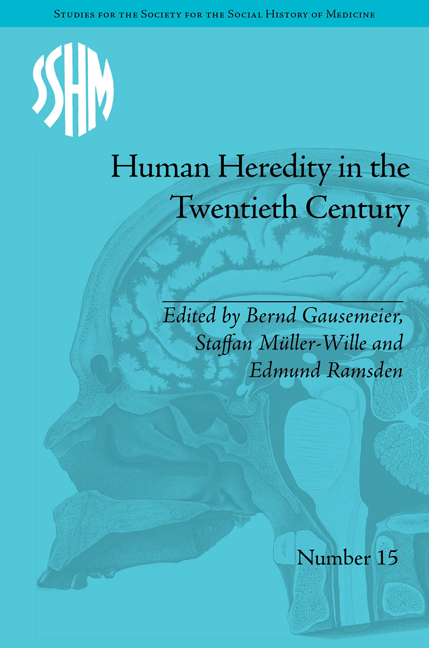Book contents
- Frontmatter
- Contents
- Acknowledgements
- List of Contributors
- List of Figures and Tables
- Introduction: Human Heredity in the Twentieth Century
- Part I Constructing Surveys of Heredity
- Part II Blood and Populations
- Part III Human Heredity in the Laboratory
- 8 From Agriculture to Genomics: The Animal Side of Human Genetics and the Organization of Model Organisms in the Longue Durée
- 9 Cereals, Chromosomes and Colchicine: Crop Varieties at the Estación Experimental Aula Dei and Human Cytogenetics, 1948–58
- 10 Putting Human Genetics on a Solid Basis: Human Chromosome Research, 1950s–1970s
- Part IV Understanding and Managing Disease
- Part V Reconstructing Discipline(s)
- Notes
- Index
9 - Cereals, Chromosomes and Colchicine: Crop Varieties at the Estación Experimental Aula Dei and Human Cytogenetics, 1948–58
from Part III - Human Heredity in the Laboratory
- Frontmatter
- Contents
- Acknowledgements
- List of Contributors
- List of Figures and Tables
- Introduction: Human Heredity in the Twentieth Century
- Part I Constructing Surveys of Heredity
- Part II Blood and Populations
- Part III Human Heredity in the Laboratory
- 8 From Agriculture to Genomics: The Animal Side of Human Genetics and the Organization of Model Organisms in the Longue Durée
- 9 Cereals, Chromosomes and Colchicine: Crop Varieties at the Estación Experimental Aula Dei and Human Cytogenetics, 1948–58
- 10 Putting Human Genetics on a Solid Basis: Human Chromosome Research, 1950s–1970s
- Part IV Understanding and Managing Disease
- Part V Reconstructing Discipline(s)
- Notes
- Index
Summary
In 1947 Enrique Sánchez-Monge, a young agronomic engineer from the Spanish city of Zaragoza, underwent a period of training at the Experimental Breeding Station of the Swedish Seed Association in Svalöf. In the laboratory, the bench next to his was occupied by the agronomist Joe Hin Tjio, a researcher from Java who had previously spent time in Denmark before meeting Sánchez-Monge at Svalöf (Figure 9.1). An invitation for Tjio to conduct research in Spain followed, initiating a decade of intersections between the two researchers, their research subjects and tools. Tjio continued his research at the Aula Dei Experimental Station in Zaragoza from 1948 until 1959, under contract as a cytologist and agronomist. The research agenda was to develop breeding and crop improvement in the middle of one of the poorest decades in twentieth-century Spain – wheat, rye and barley being basic food of both people and livestock in the first decade of the Franco dictatorship.
At that time cytology was demonstrating great promise for agricultural research, and Svalöf was a renowned experimental station for agronomists to be trained in cytology techniques that could contribute to agricultural development. At Svalöf, both SánchezMonge and Tjio were working under the Swedish cytologist Albert Levan, and even after his appointment as head of the cytology unit at Aula Dei, Tjio would spend some months in Sweden each year in order to maintain his association with Levan.
- Type
- Chapter
- Information
- Human Heredity in the Twentieth Century , pp. 127 - 140Publisher: Pickering & ChattoFirst published in: 2014



